The Hybridization of PSO for the Optimal Coordination of Directional Overcurrent Protection Relays of the IEEE Bus System
Abstract
:1. Introduction
2. Problem Formulating of DOPR
2.1. Construction of Objective Function
2.2. Construction of Constraints
3. HPSO Algorithm for DOPR Estimation
- Step 1: Initialization of the basic parameters, (Random value), (Inertia), (Acceleration Factor), T0 (Initial temperature) and α (Cooling Factor).
- Step 1.1: Initialize the generating system inside the boundary conditions of the parameters.
- Step 1.2: The initial results are obtained by evaluating the objective function with Equation (9). is obtained from the function, while is its minimum value.
- Step 2: This step is included in the iteration cycle until the required results are obtained.
- Step 2.1: Equations (12) and (13) update particle position and velocity within predetermined boundary boundaries.
- Step 2.2: and results are obtained using Equations (10) and (11).
- Step 2.3: After obtaining the as the first solution, SA is initiated here.
- Step 2.4: Function for the new solution defined concerning the previous solution.
- Step 2.5: After analyzing the previous answer, a new one is developed.
- Step 2.6: The solution is deemed satisfactory if the difference between the old and new solutions is less than 0, given in Equation (14).
- Step 2.7: If Equation (15) is not satisfied by Step 2.6, use it until it is.
- Step 2.8: The new solution is obtained from the objective function.
- Step 2.9: Update the temperature following Equation (16).
- Step 2.10: Continue Step 2 until the stopping requirement is satisfied.
- Step 3: Display the best solution, objective values, and estimated parameters.
4. Simulation Results of IEEE Bus Systems
4.1. IEEE 4-Bus System
4.2. IEEE 6-Bus System
4.3. IEEE 8-Bus System
5. Comparison Results Analysis
6. Conclusions
Author Contributions
Funding
Data Availability Statement
Conflicts of Interest
References
- Alam, M.; Chakrabarti, S.; Pradhan, A. Protection of Networked Microgrids Using Relays with Multiple Setting Groups. IEEE Trans. Ind. Inform. 2022, 18, 311–320. [Google Scholar]
- Shih, M.Y.; Enríquez, A.C.; Martín, L.; Trevi, T. Online coordination of directional overcurrent relays: Performance evaluation among optimization algorithms. Electr. Power Syst. Res. 2014, 110, 122–132. [Google Scholar]
- Irfan, M.; Wadood, A.; Khurshaid, T.; Khan, B.M.; Kim, K.; Rhee, S.B. An Optimised Adaptive Protection Scheme for Numerical and Directional Overcurrent Relay Coordination Using Harris Hawk Optimization. Energies 2021, 14, 5603. [Google Scholar]
- Albrecht, R.E.; Nisja, M.J.; Feero, W.E.; Rockefeller, G.D.; Wagner, C.L. Digital computer protective device coordination program I-general program description. IEEE Trans. Power App. Syst, Apr. 1964, 83, 402–410. [Google Scholar]
- Urdaneta, A.J.; Nadira, R.; Jimenez, L.G.P. Optimal coordination of directional overcurrent relays in interconnected power systems. IEEE Trans. Power Del. 1988, 3, 903–911. [Google Scholar] [CrossRef]
- Jenkins, L.; Khincha, H.P.; Shivakumar, S.; Dash, P.K. An application of functional dependencies to the topological analysis of protection schemes. IEEE Trans. Power Del. 1992, 7, 77–83. [Google Scholar]
- Sevkli, M.; Guner, A.R. A continuous particle swarm optimization algorithm for uncapacitated facility location problem. In Ant Colony Optimization and Swarm Intelligence; Springer: Berlin/Heidelberg, Germany, 2006. [Google Scholar]
- Singh, M.; Panigrahi, B.K.; Abhyankar, A.R.; Das, S. Optimal coordination of directional over-current relays using informative differential evolution algorithm. J. Comput. Sci. 2014, 5, 269–276. [Google Scholar]
- Bukhari, S.B.A.; Mehmood, K.K.; Wadood, A.; Park, H. Intelligent Islanding Detection of Microgrids Using Long Short-Term Memory Networks. Energies 2021, 14, 18–28. [Google Scholar]
- Haider, Z.M.; Mehmood, K.K.; Khan, S.U.; Khan, M.O.; Wadood, A.; Rhee, S.B. Optimal Management of a Distribution Feeder during Contingency and Overload Conditions by Harnessing the Flexibility of Smart Loads. IEEE Access 2021, 9, 40124–40139. [Google Scholar]
- Mosavi, S.M.A.; Kejani, T.A.; Javadi, H. Optimal setting of directional over-current relays in distribution networks considering transient stability. Int. Trans. Elect. Energy Syst. 2016, 26, 122–133. [Google Scholar]
- Chattopadhyay, B.; Sachdev, M.S.; Sidhu, T.S. An online relay coordination algorithm for adaptive protection using linear programming technique. IEEE Trans. Power Deliv. 1996, 11, 165–173. [Google Scholar] [CrossRef]
- Urdaneta, A.J.; Perez, L.G.; Restrepo, H. Optimal coordination of directional overcurrent relay considering dynamic changes in the network topology. IEEE Trans. Power Deliv. 1997, 12, 1458–1464. [Google Scholar] [CrossRef]
- Wadood, A.; Kim, C.-H.; Farkoush, S.G.; Rhee, S.B. An Adaptive Protective Coordination Scheme for Distribution System Using Digital Overcurrent Relays. In Proceedings of the Korean Institute of Illuminating and Electrical Installation Engineers, Gangwon, Korea, 30 August 2017; pp. 53–58. [Google Scholar]
- Abhyaneh, H.A.; Al-Dabbagh, M.; Karegar, H.K.; Sadeghi, S.H.H.; Khan, R.A.J. A new optimal approach for coordination of directional overcurrent relays in interconnected power system. IEEE Trans. Power Deliv. 2003, 18, 430–435. [Google Scholar]
- Farkoush, S.G.; Khurshaid, T.; Wadood, A.; Kim, C.-H.; Kharal, K.H.; Kim, K.-H.; Cho, N.; Rhee, S.-B. investigation and optimization of grounding grid based on the lightning response using ATP-EMTP and genetic algorithm. Complexity 2018, 2018, 8261413. [Google Scholar]
- Moravej, Z.; Adelnia, F.; Abbasi, F. Optimal coordination of directional overcurrent relays using NSGA-II. Electr. Power Syst. Res. 2015, 119, 228–236. [Google Scholar] [CrossRef]
- Bedekar, P.P.; Bhide, S.R. Optimum coordination of overcurrent relay timing using continuous genetic algorithm. Expert Syst. Appl. 2011, 38, 11286–11292. [Google Scholar]
- Razavi, F.; Abyaneh, H.A.; Al-Dabbagh, M.; Mohammadi, R.; Torkaman, H. A new comprehensive genetic algorithm method for optimal overcurrent relay coordination. Electr. Power Syst. Res. 2008, 78, 713–720. [Google Scholar]
- Wadood, A.; Kim, C.-H.; Khurshiad, T.; Farkoush, S.G.; Rhee, S.-B. Application of a tenuous particle swarm optimization (CPSO) for the optimal coordination of overcurrent relays considering a penalty method. Energies 2018, 11, 869. [Google Scholar] [CrossRef]
- Khurshaid, T.; Wadood, A.; Farkoush, S.G.; Kim, C.-H.; Cho, N.; Rhee, S.-B. Modified particle swarm optimizer to optimize time dial settings for directional overcurrent relay coordination. J. Elect. Eng. Technol. 2019, 14, 55–68. [Google Scholar]
- Park, J.B.; Lee, K.S.; Shin, J.R.; Lee, K.Y. A Particle swarm optimization for economic dispatch with non-smooth cost functions. IEEE Trans. Power Syst. 2005, 20, 34–42. [Google Scholar] [CrossRef]
- Sulaiman, M.; Waseem; Muhammad, S.; Khan, A. Improved solutions for the optimal coordination of DOCRs using firefly algorithm. Complexity 2018, 2018, 7039790. [Google Scholar]
- Gokhale, S.S.; Kale, V.S. An application of a tent map initiated Chaotic Firefly algorithm for optimal overcurrent relay coordination. Int. J. Electr. Power Energy Syst. 2016, 78, 336–342. [Google Scholar] [CrossRef]
- Khurshaid, T.; Wadood, A.; Farkoush, S.G.; Kim, C.H.; Yu, J.; Rhee, S.B. Improved firefly algorithm for the optimal coordination of directional overcurrent relays. IEEE Access 2019, 7, 78503–78514. [Google Scholar] [CrossRef]
- Thangaraj, R.; Pant, M.; Deep, K. Optimal coordination of overcurrent relays using modified differential evolution algorithms. Eng. Appl. Artif. Intell. 2010, 23, 9–20. [Google Scholar]
- Chelliah, T.R.; Thangaraj, R.; Allamsetty, S.; Pant, M. Coordination of directional overcurrent relays using opposition based chaotic differential evolution algorithm. Int. J. Electr. Power Energy Syst. 2014, 55, 341–350. [Google Scholar] [CrossRef]
- Noghabi, A.S.; Sadeh, J.; Mashhadi, H.R. Considering different network topologies in optimal overcurrent relay coordination using a hybrid GA. IEEE Trans. Power Del. 2009, 24, 1857–1863. [Google Scholar] [CrossRef]
- Yang, M.T.; Liu, A. Applying hybrid PSO to optimize directional overcurrent relay coordination in different network topologies. J. Appl. Math. 2013, 2013, 20131–20139. [Google Scholar] [CrossRef]
- Ghanbari, M.; Gandomkar, M.; Nikoukar, J. Protection Coordination of Bidirectional Overcurrent Relay Using Developed Particle Swarm Optimization Approach Considering Distribution Generation Penetration and Fault Current Limiter Placement. IEEE Can. J. Electr. Comput. Eng. 2021, 44. [Google Scholar]
- Singh, M.; Panigrahi, B.K.; Abhyankar, A.R.; Das, S. Optimal coordination of directional over-current relays using teaching. learning-based optimization (TLBO) algorithm. Int. J. Electr. Power Energy Syst. 2013, 50, 33–41. [Google Scholar] [CrossRef]
- Amraee, T. Coordination of directional overcurrent relays using seeker algorithm. IEEE Trans. Power Deliv. 2012, 27, 1415–1422. [Google Scholar]
- Albasri, F.A.; Alroomi, A.R.; Talaq, J.H. Optimal coordination of directional overcurrent relays using biogeography-based optimization algorithms. IEEE Trans. Power Deliv. 2015, 30, 1810–1820. [Google Scholar] [CrossRef]
- Ezzeddine, M.; Kaczmarek, R.; Iftikhar, M.U. Coordination of directional overcurrent relays using a novel method to select their settings, IET Gener. Transmiss. Distrib. 2007, 5, 743–750. [Google Scholar] [CrossRef]
- Damchi, Y.; Dolatabadi, M.; Mashhadi, H.R.; Sadeh, J. MILP approach for optimal coordination of directional overcurrent relays in interconnected power systems. Electr. Power Syst. Res. 2018, 158, 267–274. [Google Scholar] [CrossRef]
- Bouchekara, H.R.E.H.; Zellagui, M.; Abido, M.A. Optimal coordination of directional overcurrent relays using a modified electromagnetic field optimization algorithm. Appl. Soft Comput. 2017, 54, 267–283. [Google Scholar] [CrossRef]
- Habib, K.; Lai, X.; Wadood, A.; Khan, S.; Wang, Y.; Xu, S. Hybridization of PSO for the Optimal Coordination of Directional Overcurrent Protection Relays. Electronics 2022, 11, 180. [Google Scholar] [CrossRef]
- Habib, K.; Lai, X.; Wadood, A.; Khan, S.; Wang, Y.; Xu, S. An improved technique of Hybridization of PSO for the Optimal Coordination of Directional Overcurrent Protection Relays of IEEE bus system. Energies 2022, 15, 3076. [Google Scholar] [CrossRef]
- Bedekar, P.P.; Bhide, S.R.; Kale, V.S. Optimum coordination of overcurrent relays in distribution system using the dual simplex method. In Proceedings of the 2009 2nd International Conference on Emerging Trends in Engineering and Technology (ICETET), Nagpur, India, 16–18 December 2009. [Google Scholar]
- Kennedy, J.; Eberhart, R. Particle Swarm Optimization. In Proceedings of the IEEE International Conference on Neural Networks, Perth, WA, Australia, 27 November–1 December 1995; Volume IV, pp. 1942–1948. [Google Scholar]
- Kirkpatrick, S.; Gellat, C.D.; Vecchi, M.P. Optimization by Simulated Annealing. Science 1983, 220, 671–680. [Google Scholar] [CrossRef]

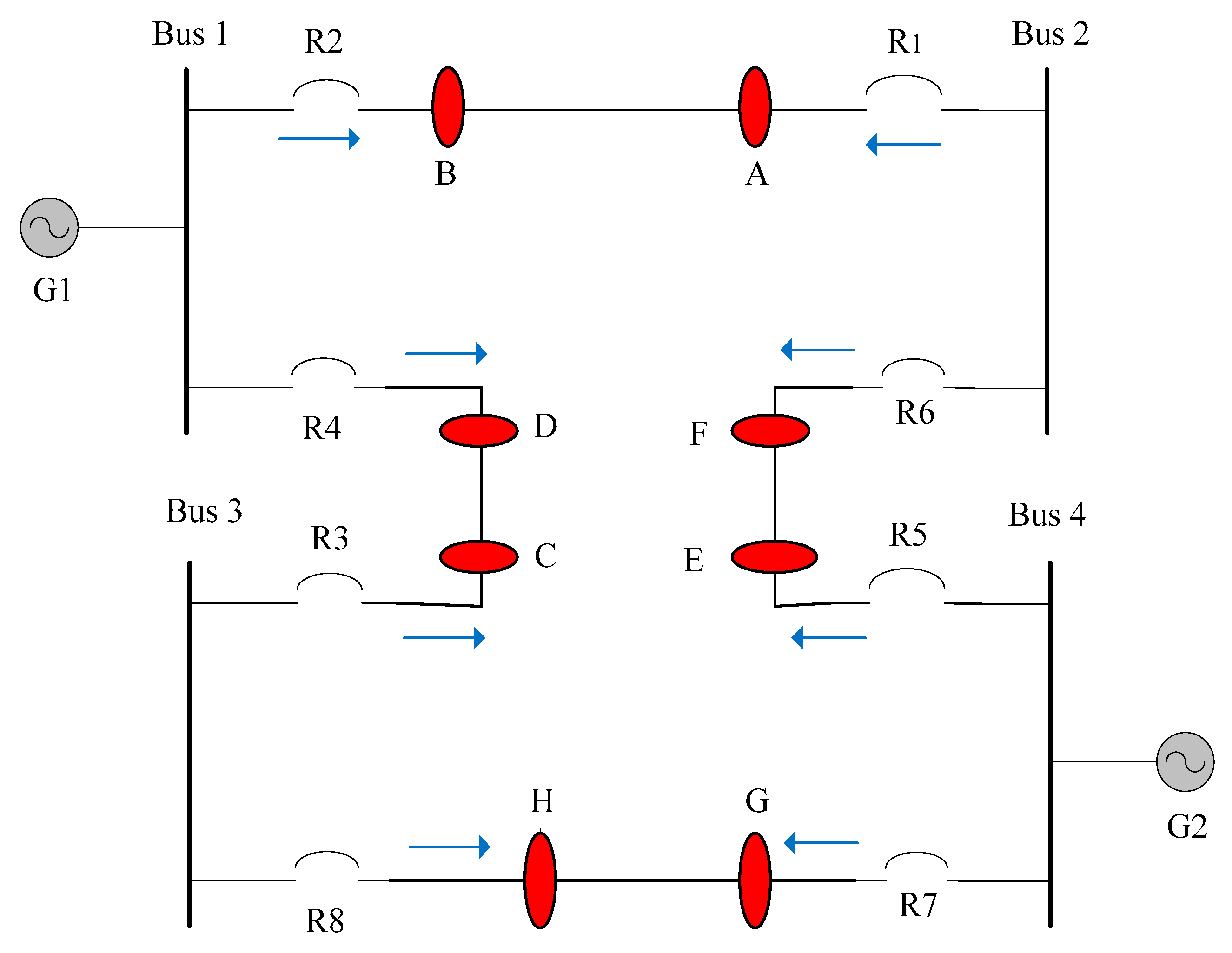
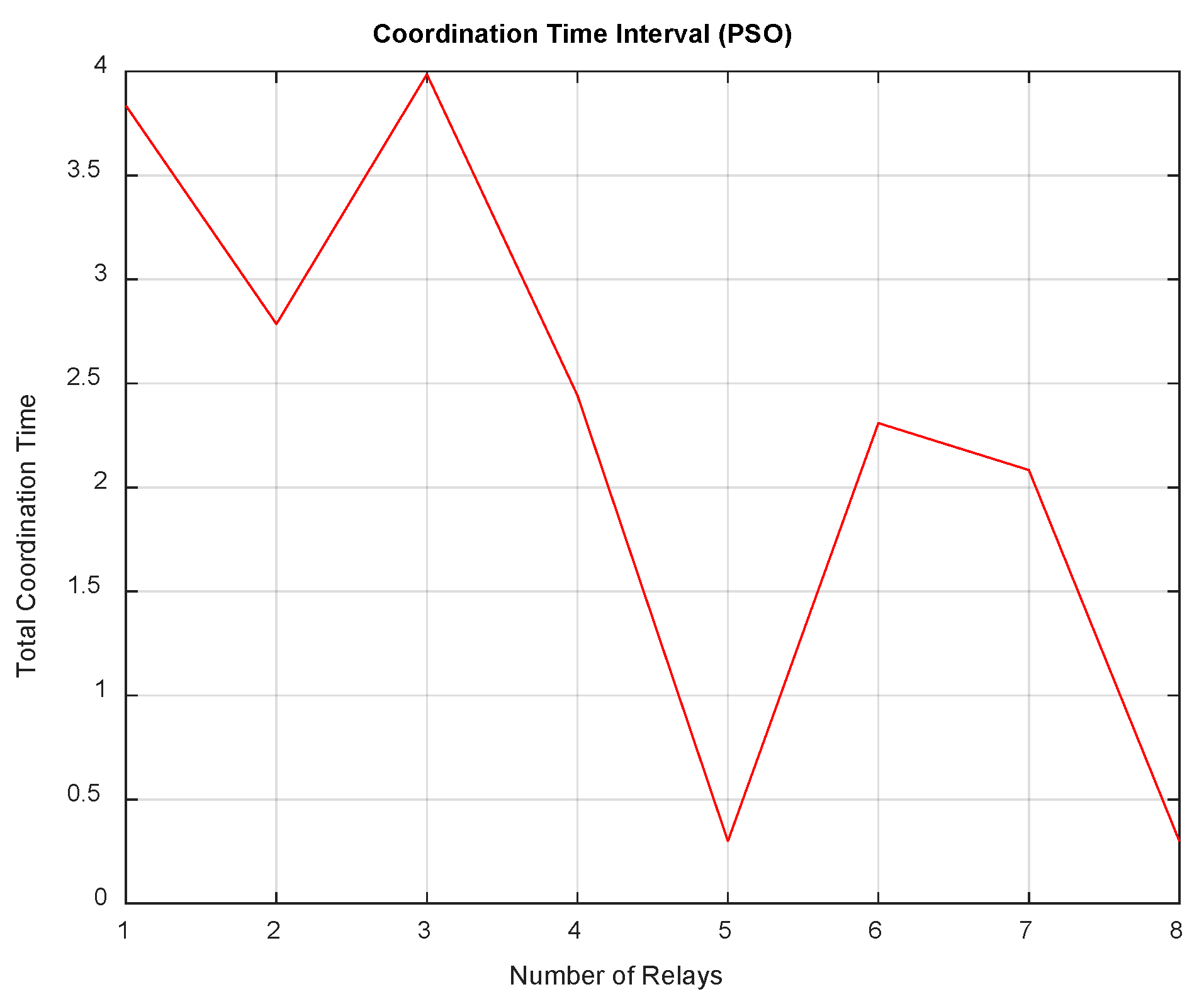
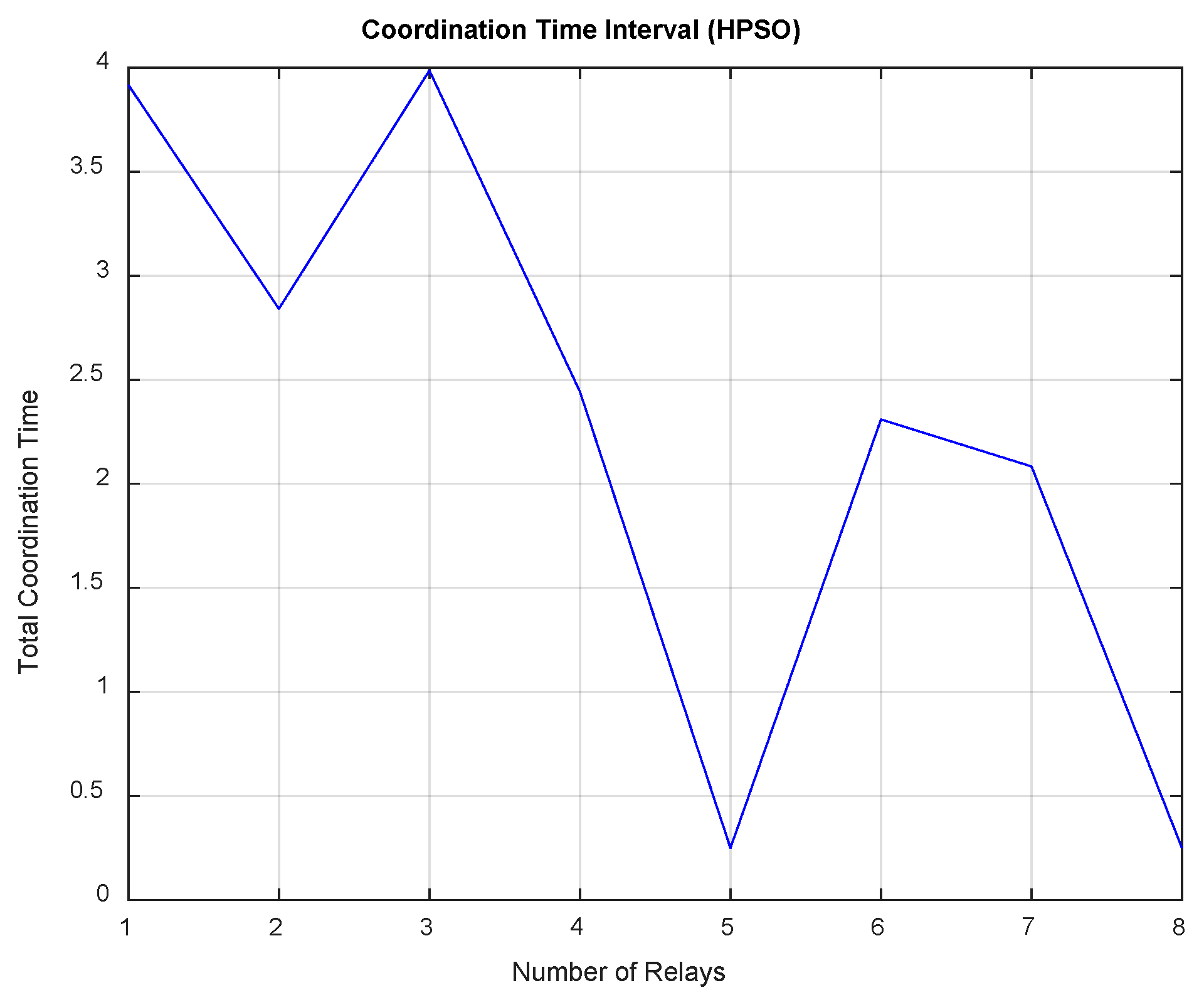
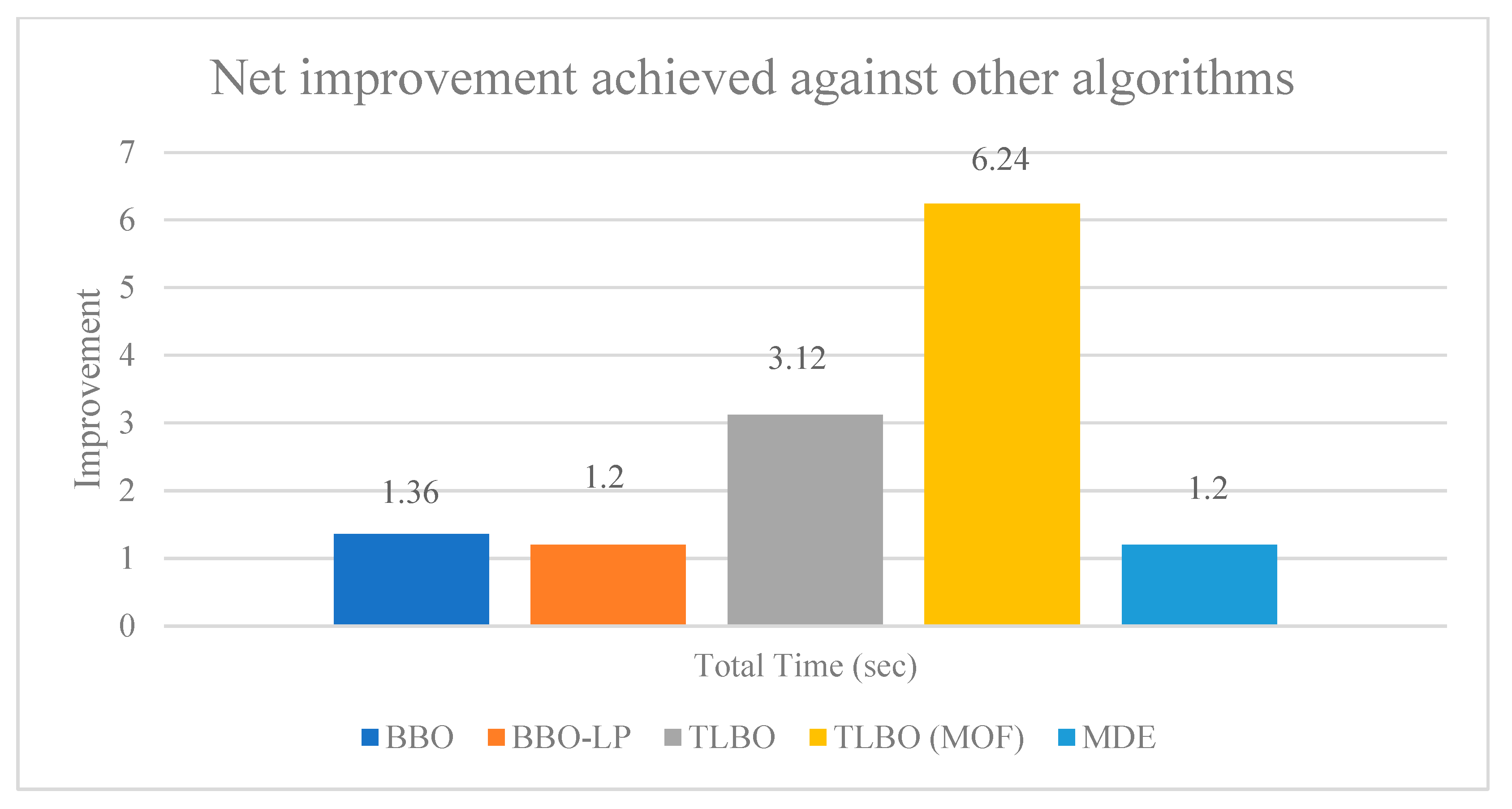
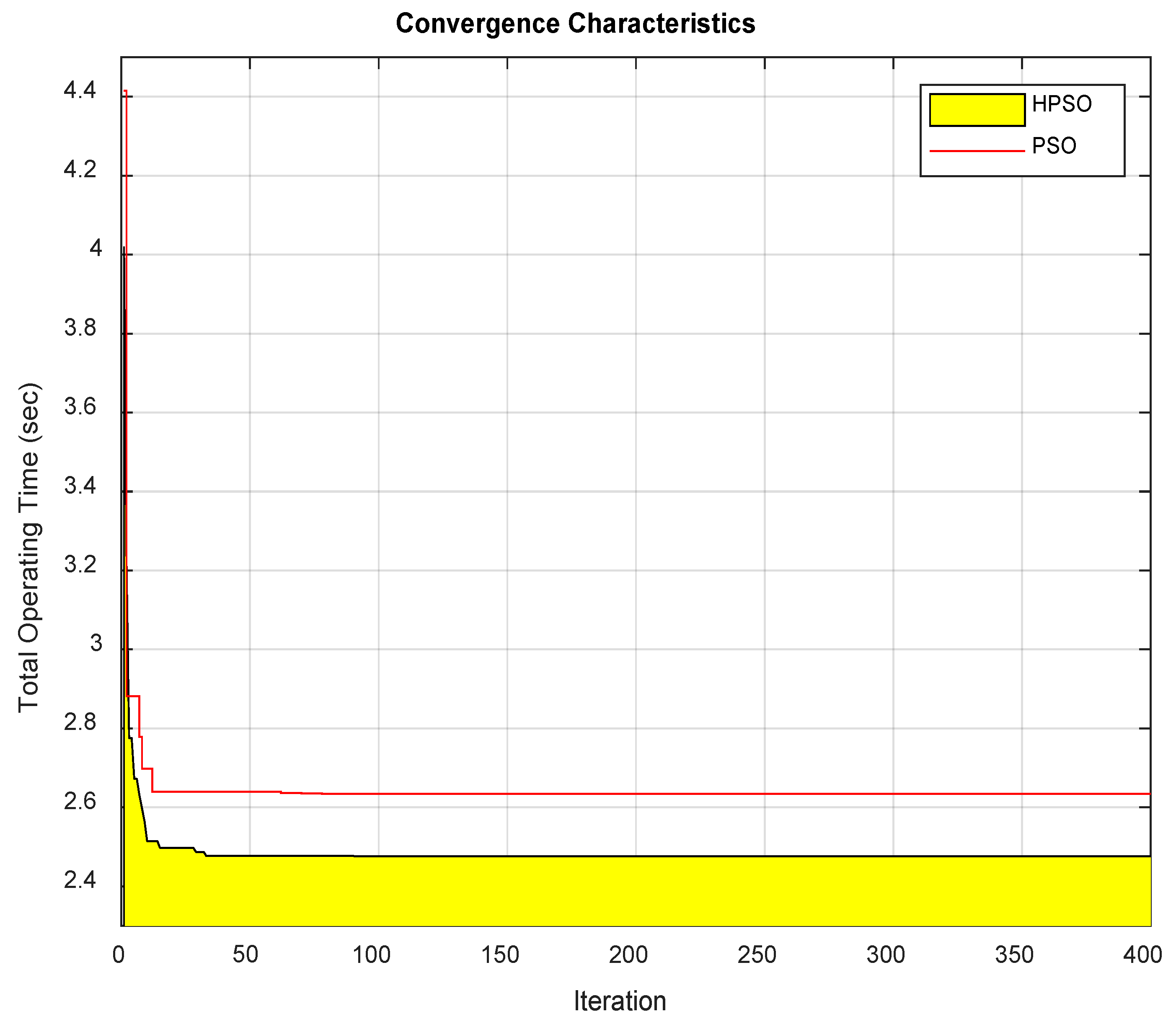
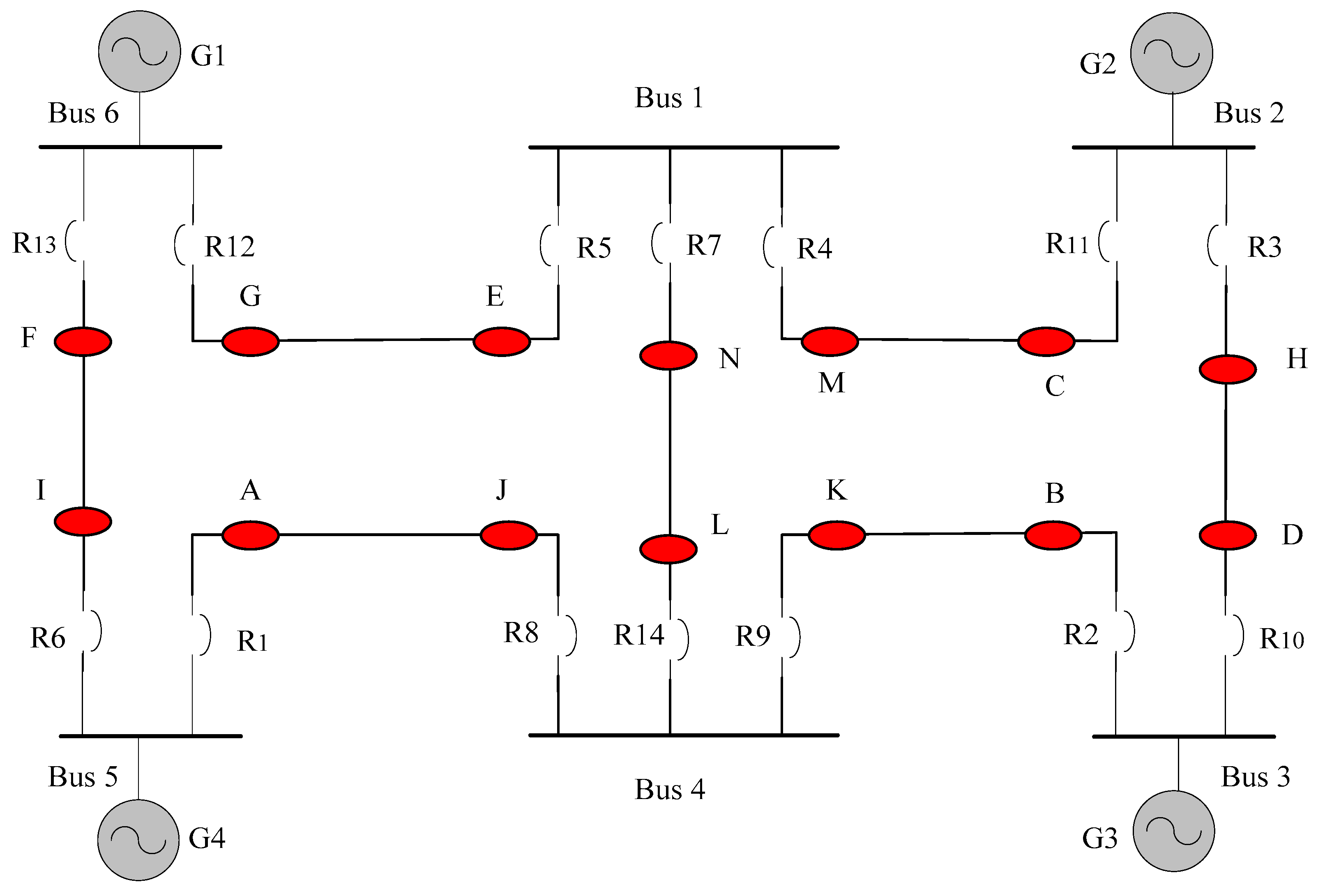
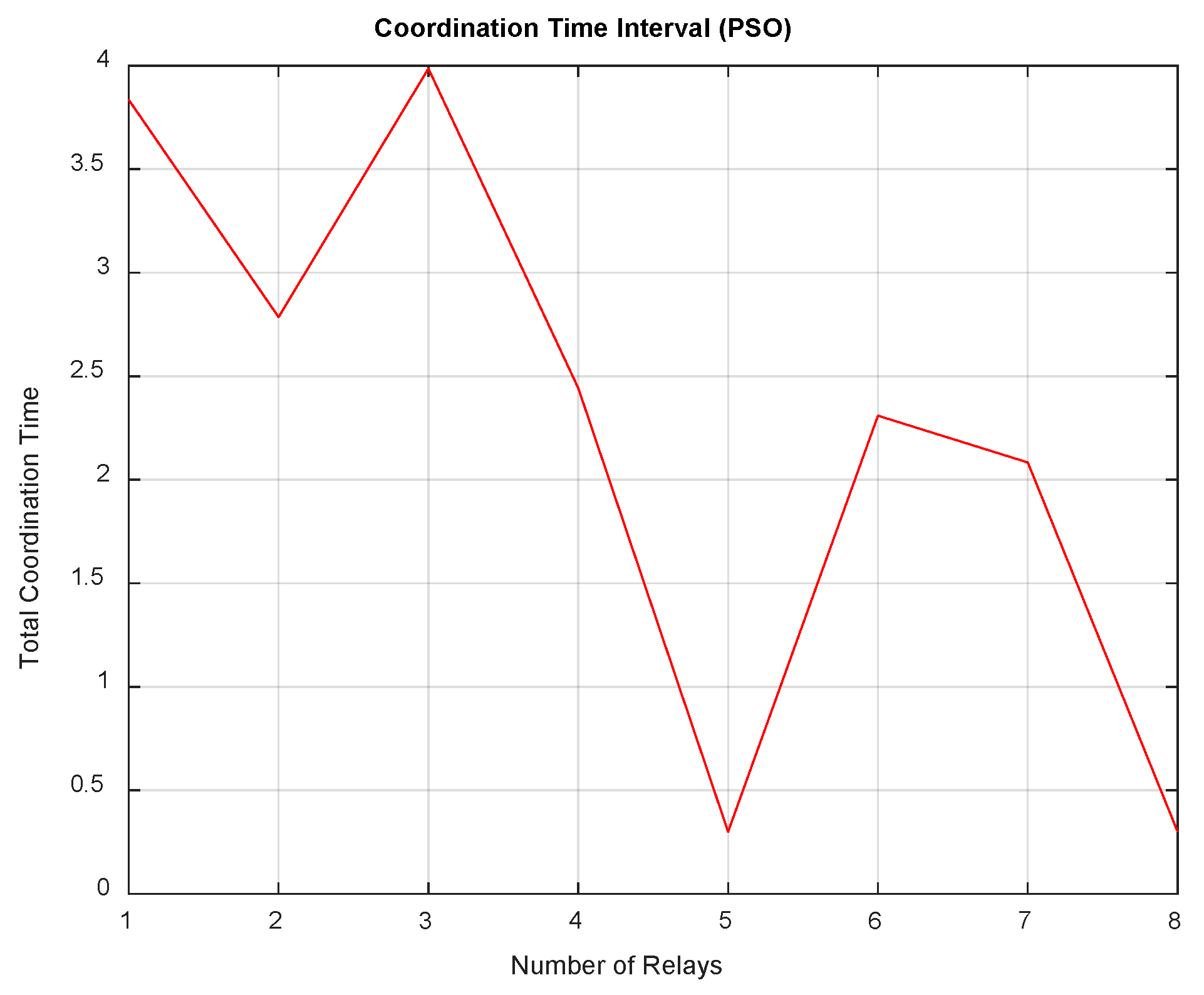
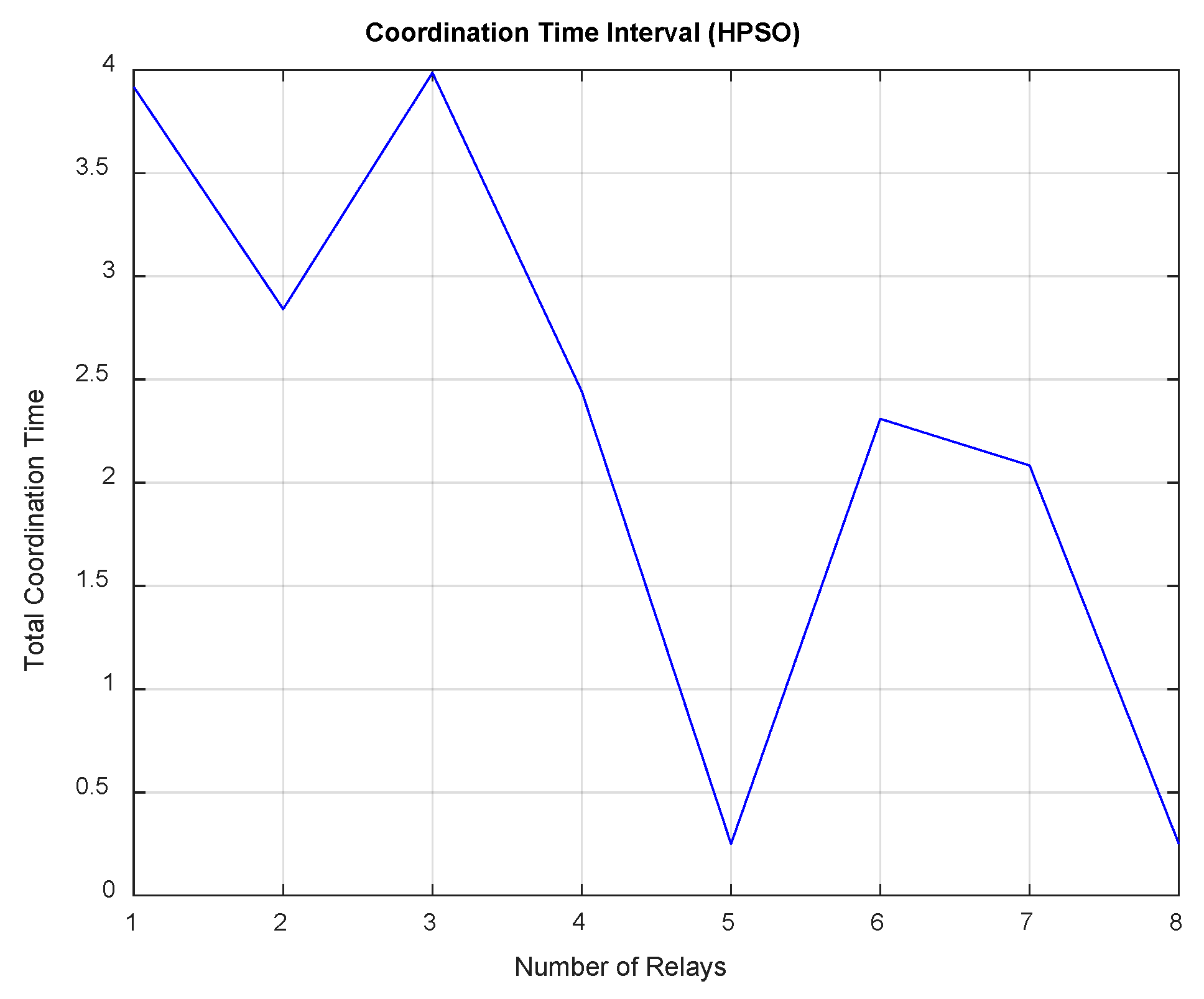
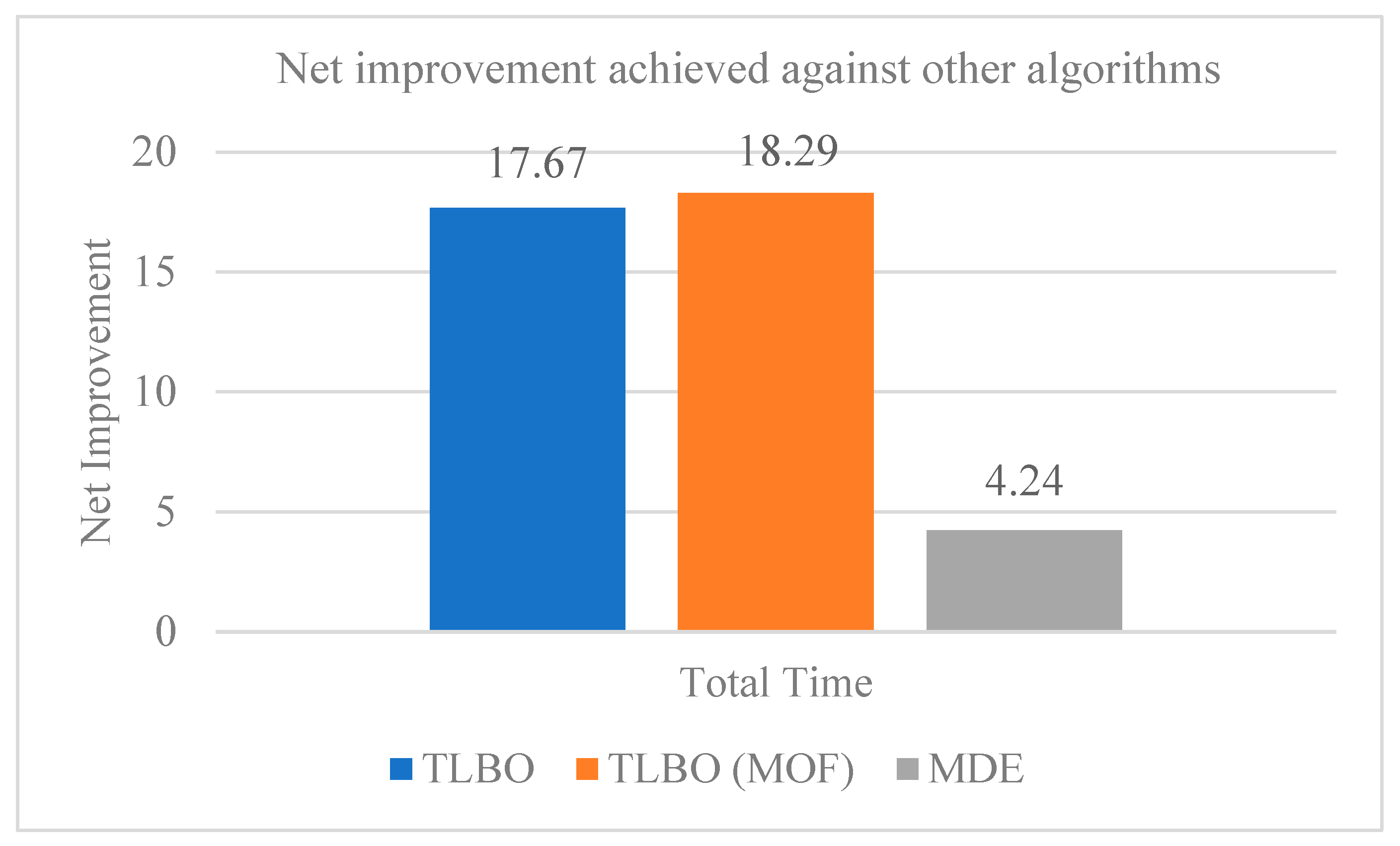


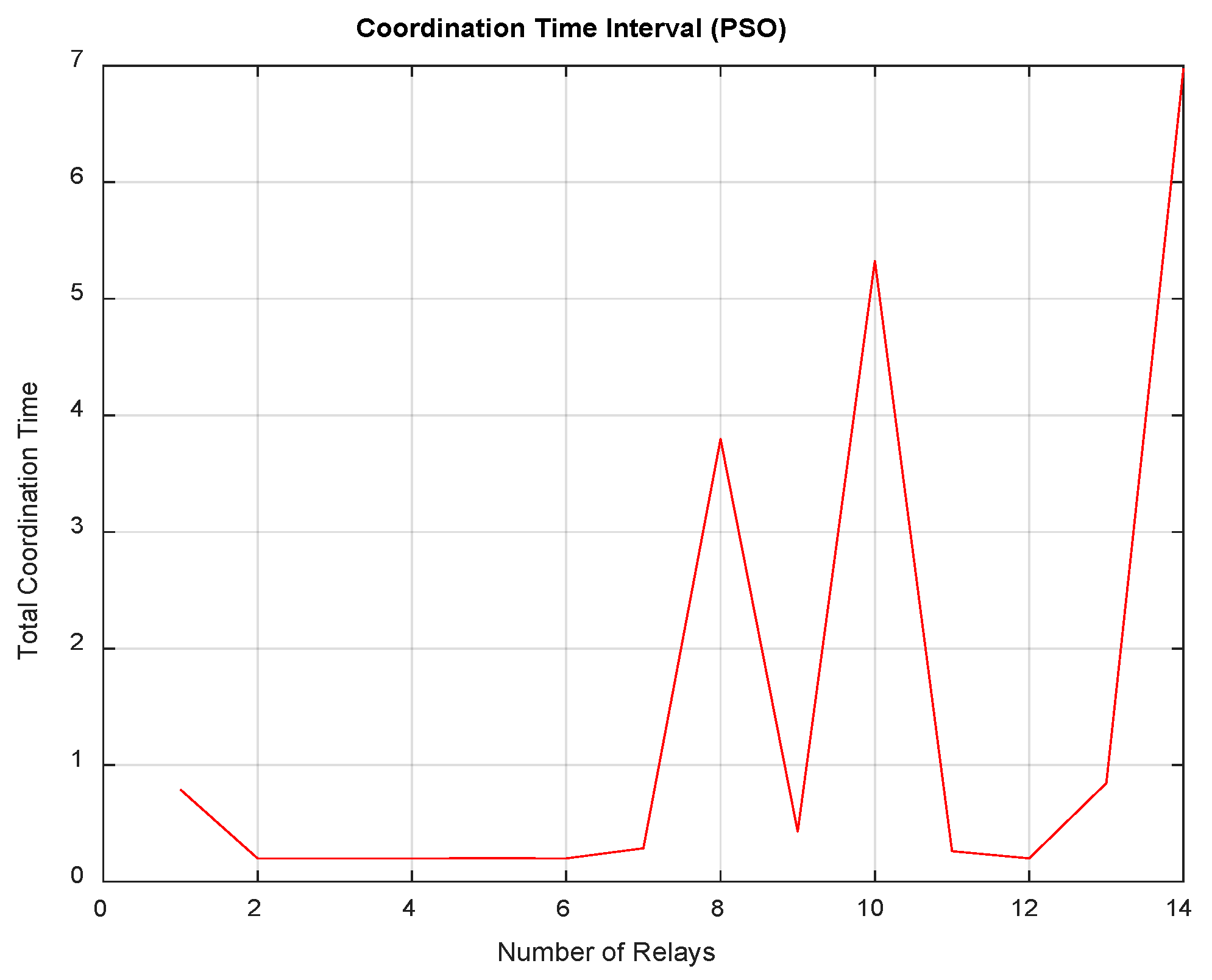

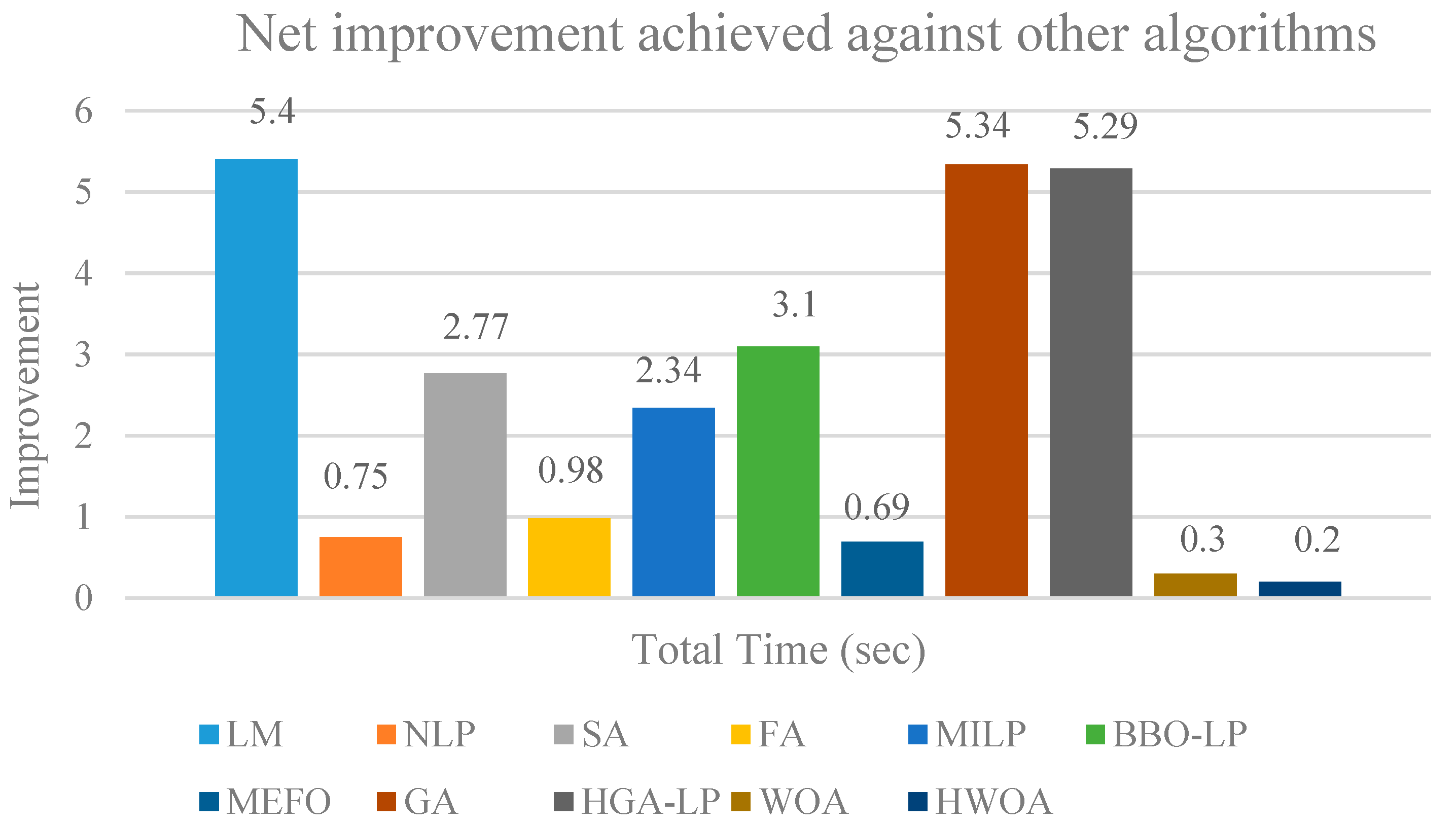
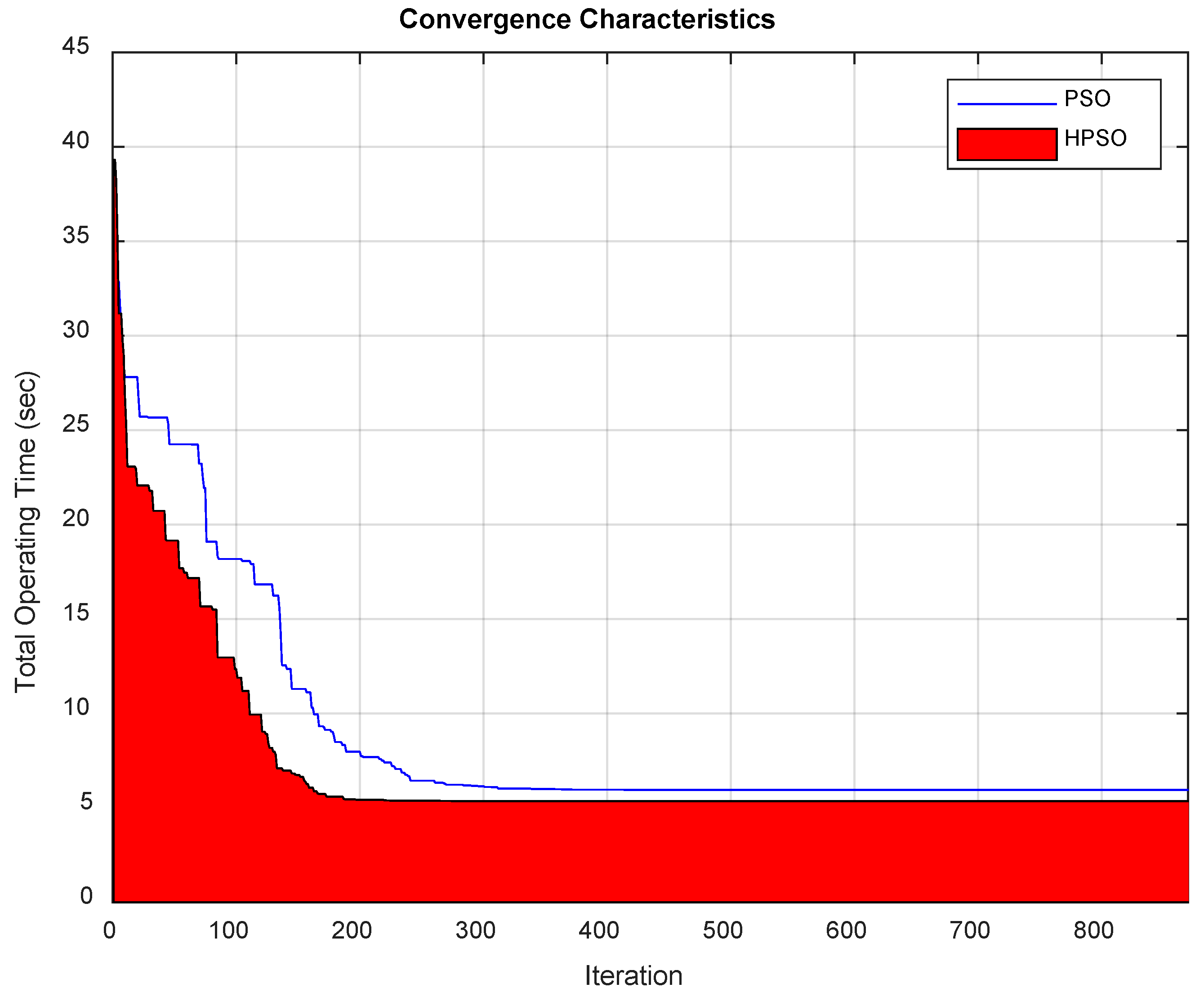
| TMS | PSO | HPSO | TMS | PSO | HPSO |
|---|---|---|---|---|---|
| Relay (R1) | 0.3099 | 0.2698 | Relay (R5) | 1.1 | 1.1 |
| Relay (R2) | 1.1 | 1.1 | Relay (R6) | 0.1 | 0.1 |
| Relay (R3) | 0.1 | 0.1 | Relay (R7) | 1.1 | 1.1 |
| Relay (R4) | 0.1565 | 0.1432 | Relay (R8) | 0.1 | 0.1 |
| 2.6345 | 2.4763 |
| Relays | Relays Operating Time (s) | Relays | Relays Operating Time (s) | ||
|---|---|---|---|---|---|
| PSO | HPSO | PSO | HPSO | ||
| Relay (R1) | 0.6280 | 0.5468 | Relay (R5) | 0.2507 | 0.2294 |
| Relay (R2) | 0.4291 | 0.3736 | Relay (R6) | 0.3456 | 0.3456 |
| Relay (R3) | 0.3361 | 0.3361 | Relay (R7) | 0.1963 | 0.1963 |
| Relay (R4) | 0.1601 | 0.1601 | Relay (R8) | 0.2885 | 0.2885 |
| Relays | Relays Operating Time (s) | Relays | Relays Operating Time (s) | ||
|---|---|---|---|---|---|
| PSO | HPSO | PSO | HPSO | ||
| Relay (R1) | 4.4633 | 4.4633 | Relay (R5) | 0.5507 | 0.4794 |
| Relay (R2) | 3.2149 | 3.2149 | Relay (R6) | 2.6550 | 2.6550 |
| Relay (R3) | 4.3220 | 4.3220 | Relay (R7) | 2.2799 | 2.2799 |
| Relay (R4) | 2.6030 | 2.6030 | Relay (R8) | 0.5885 | 0.5384 |
| Technique | Objective Function (F) |
|---|---|
| BBO [33] | 3.8282 |
| BBO-LP [33] | 3.6698 |
| TLBO [31] | 5.589 |
| TLBO (MOF) [31] | 8.7088 |
| MDE [26] | 3.6694 |
| PSO | 2.6345 |
| HPSO | 2.4763 |
| Relay | CT Ratio |
|---|---|
| 1, 6, 13 | 1200:5 |
| 2, 3, 4, 5, 7, 8, 9, 11, 12, 14 | 800:5 |
| 10 | 600:5 |
| Primary Relay | Fault Current (A) | Backup Relay | Fault Current (A) |
|---|---|---|---|
| 9 | 6072 | 1 | 4589 |
| 14 | 5457 | 1 | 4589 |
| 8 | 2351 | 2 | 868 |
| 14 | 5457 | 2 | 868 |
| 2 | 4803 | 3 | 1365 |
| 3 | 30,547 | 4 | 552.8 |
| 13 | 17,821 | 5 | 977 |
| 12 | 17,705 | 6 | 861 |
| 8 | 2351 | 7 | 1483 |
| 9 | 6072 | 7 | 1483 |
| 6 | 18,338 | 8 | 767 |
| 10 | 4077 | 9 | 639 |
| 11 | 30,939 | 10 | 945.5 |
| 5 | 2838 | 11 | 1074 |
| 7 | 4496 | 11 | 1074 |
| 4 | 5186 | 12 | 3422 |
| 7 | 4496 | 12 | 3422 |
| 1 | 18,172 | 13 | 601 |
| 4 | 5186 | 14 | 1764 |
| 5 | 2838 | 14 | 1764 |
| TMS | PSO | HPSO | TMS | PSO | HPSO |
|---|---|---|---|---|---|
| Relay (R1) | 0.1985 | 0.1602 | Relay (R8) | 1.10 | 1.10 |
| Relay (R2) | 0.050 | 0.050 | Relay (R9) | 1.10 | 0.050 |
| Relay (R3) | 0.1606 | 0.1293 | Relay (R10) | 1.10 | 1.10 |
| Relay (R4) | 0.050 | 0.050 | Relay (R11) | 1.10 | 1.10 |
| Relay (R5) | 0.050 | 0.050 | Relay (R12) | 1.10 | 1.10 |
| Relay (R6) | 0.050 | 0.050 | Relay (R13) | 1.10 | 1.10 |
| Relay (R7) | 0.050 | 1.10 | Relay (R14) | 1.10 | 1.10 |
| 6.965 | 6.112 |
| Relays | Relays Operating Time (s) | Relays | Relays Operating Time (s) | ||
|---|---|---|---|---|---|
| PSO | HPSO | PSO | HPSO | ||
| Relay (R1) | 0.9979 | 0.8054 | Relay (R8) | 0.5395 | 0.4344 |
| Relay (R2) | 0.6971 | 0.5626 | Relay (R9) | 0.1854 | 0.1854 |
| Relay (R3) | 0.6684 | 0.5395 | Relay (R10) | 0.2186 | 0.2186 |
| Relay (R4) | 0.1442 | 0.1442 | Relay (R11) | 0.8902 | 0.8902 |
| Relay (R5) | 0.2129 | 0.2129 | Relay (R12) | 0.2728 | 0.2728 |
| Relay (R6) | 0.8318 | 0.6697 | Relay (R13) | 0.4270 | 0.4270 |
| Relay (R7) | 0.6654 | 0.5357 | Relay (R14) | 0.2140 | 0.2140 |
| Relays | Relays Operating Time (s) | Relays | Relays Operating Time (s) | ||
|---|---|---|---|---|---|
| PSO | HPSO | PSO | HPSO | ||
| Relay (R1) | 9.3076 | 9.3076 | Relay (R8) | 4.8731 | 4.8731 |
| Relay (R2) | 4.9432 | 4.9432 | Relay (R9) | 0.5902 | 0.4763 |
| Relay (R3) | 8.1679 | 8.1679 | Relay (R10) | 0.5187 | 0.4186 |
| Relay (R4) | 0.6000 | 0.4831 | Relay (R11) | 4.5542 | 4.5542 |
| Relay (R5) | 0.5128 | 0.4129 | Relay (R12) | 6.2699 | 6.2699 |
| Relay (R6) | 7.6106 | 7.6106 | Relay (R13) | 6.3894 | 6.3894 |
| Relay (R7) | 5.4057 | 5.4057 | Relay (R14) | 0.6196 | 0.4989 |
| Technique | Objective Function (F) |
|---|---|
| TLBO [31] | 23.7828 |
| TLBO (MOF) [31] | 24.3906 |
| MDE [26] | 10.3514 |
| PSO | 6.965 |
| HPSO | 6.112 |
| Relay | CT Ratio |
|---|---|
| 1, 2, 4, 5, 6, 8, 10, 11, 12, 13 | 1200:5 |
| 3, 7, 9, 14 | 800:5 |
| Primary Relay | Fault Current (A) | Backup Relay | Fault Current (A) |
|---|---|---|---|
| 1 | 3232 | 6 | 3232 |
| 2 | 5924 | 1 | 996 |
| 2 | 5924 | 7 | 1890 |
| 3 | 3556 | 2 | 3556 |
| 4 | 3783 | 3 | 2244 |
| 5 | 2401 | 4 | 2401 |
| 6 | 6109 | 5 | 1197 |
| 6 | 6109 | 14 | 1874 |
| 7 | 5223 | 5 | 1197 |
| 7 | 5223 | 13 | 987 |
| 8 | 6093 | 7 | 1890 |
| 8 | 6093 | 9 | 1165 |
| 9 | 2484 | 10 | 2484 |
| 10 | 3883 | 11 | 2344 |
| 11 | 3707 | 12 | 3707 |
| 12 | 5899 | 13 | 987 |
| 12 | 5899 | 14 | 1874 |
| 13 | 2991 | 8 | 2991 |
| 14 | 5199 | 1 | 996 |
| 14 | 5199 | 9 | 1165 |
| TMS | PSO | HPSO | TMS | PSO | HPSO |
|---|---|---|---|---|---|
| Relay 1 | 0.1429 | 0.1271 | Relay 8 | 0.10 | 0.10 |
| Relay 2 | 0.1179 | 0.1034 | Relay 9 | 0.1624 | 0.1492 |
| Relay 3 | 0.1271 | 0.1124 | Relay 10 | 0.10 | 0.10 |
| Relay 4 | 0.1210 | 0.1092 | Relay 11 | 1.20 | 0.14 |
| Relay 5 | 0.10 | 0.10 | Relay 12 | 1.20 | 0.131 |
| Relay 6 | 0.10 | 0.10 | Relay 13 | 1.198 | 0.130 |
| Relay 7 | 0.1643 | 0.1467 | Relay 14 | 1.20 | 0.8108 |
| 5.948 | 5.6657 |
| No. of Relays | Operating Time of Each Relay (s) | No. of Relays | Operating Time of Each Relay (s) | ||
|---|---|---|---|---|---|
| PSO | HPSO | PSO | HPSO | ||
| Relay 1 | 0.5841 | 0.5195 | Relay 8 | 0.2950 | 0.2950 |
| Relay 2 | 0.3522 | 0.3215 | Relay 9 | 0.6184 | 0.5898 |
| Relay 3 | 0.4556 | 0.4158 | Relay 10 | 0.4946 | 0.4717 |
| Relay 4 | 0.3872 | 0.3649 | Relay 11 | 0.3774 | 0.3774 |
| Relay 5 | 0.6024 | 0.5436 | Relay 12 | 0.2993 | 0.2993 |
| Relay 6 | 0.2947 | 0.2947 | Relay 13 | 0.5537 | 0.5428 |
| Relay 7 | 0.3165 | 0.3165 | Relay 14 | 0.3172 | 0.3172 |
| No. of Relays | Operating Time of Each Relay (s) | No. of Relays | Operating Time of Each Relay (s) | ||
|---|---|---|---|---|---|
| PSO | HPSO | PSO | HPSO | ||
| Relay 1 | 1.3742 | 1.3742 | Relay 8 | 4.0917 | 4.0917 |
| Relay 2 | 0.5522 | 0.4911 | Relay 9 | 1.0480 | 1.0480 |
| Relay 3 | 0.6555 | 0.6251 | Relay 10 | 5.8193 | 5.4890 |
| Relay 4 | 0.5869 | 0.5357 | Relay 11 | 0.6390 | 0.6095 |
| Relay 5 | 0.8028 | 0.7567 | Relay 12 | 0.4993 | 0.4895 |
| Relay 6 | 0.4946 | 0.4463 | Relay 13 | 1.3994 | 1.3994 |
| Relay 7 | 0.6031 | 0.6031 | Relay 14 | 7.2919 | 0.8507 |
Disclaimer/Publisher’s Note: The statements, opinions and data contained in all publications are solely those of the individual author(s) and contributor(s) and not of MDPI and/or the editor(s). MDPI and/or the editor(s) disclaim responsibility for any injury to people or property resulting from any ideas, methods, instructions or products referred to in the content. |
© 2023 by the authors. Licensee MDPI, Basel, Switzerland. This article is an open access article distributed under the terms and conditions of the Creative Commons Attribution (CC BY) license (https://creativecommons.org/licenses/by/4.0/).
Share and Cite
Wang, Y.; Habib, K.; Wadood, A.; Khan, S. The Hybridization of PSO for the Optimal Coordination of Directional Overcurrent Protection Relays of the IEEE Bus System. Energies 2023, 16, 3726. https://doi.org/10.3390/en16093726
Wang Y, Habib K, Wadood A, Khan S. The Hybridization of PSO for the Optimal Coordination of Directional Overcurrent Protection Relays of the IEEE Bus System. Energies. 2023; 16(9):3726. https://doi.org/10.3390/en16093726
Chicago/Turabian StyleWang, Yuheng, Kashif Habib, Abdul Wadood, and Shahbaz Khan. 2023. "The Hybridization of PSO for the Optimal Coordination of Directional Overcurrent Protection Relays of the IEEE Bus System" Energies 16, no. 9: 3726. https://doi.org/10.3390/en16093726






